|
Chapter 5 The
Town and Buildings
Although the town existed before the seventeenth century the
Rawdon family were largely responsible for building the houses
and for the towns development. In 1744 Moira was described as
"a well laid out and thriving village, consisting of one broad
street, inhabited by many traders, many of whom carry on the
linen trade to good advantage". In 1740 a monthly brown linen
market was established. Although linen was the main industry,
there was also a brewery and bottling business near "Palmer's
Corner". Lambeg drums were also reputed to have been first
made in the town. Moira was also an important centre for
limestone quarrying. Evidence of this is seen in the lime
kilns on the Clarehill Road. Another similar business existed
until recently on the Old Kilmore Road.
The Market House was built by the Bateson
family, who although they resided at Belvoir Park continued to
care for the town. This building bears the Bateson family
crest. The Market House contained a large assembly room and a
court room, which was still in use by the Courts until the
early part of this century. Perhaps the
earliest existing building is Berwick Hall, a thatched house
on the Hillsborough Road which dates back to circa 1700. It
was owned by the Berwick family and is one of the finest
examples of a yeoman's home. Other buildings of
note in the Main Street include the residence (near the
Demesne entrance) which was the home of the land steward Mr.
John L. Douie. There is also a building opposite the Market
House bearing the date 1735.
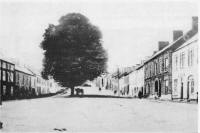 |
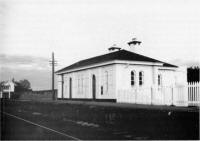
|
| The Main
Street of Moira was lined down both sides with lime
trees |
The Railway
Station was the earliest country station on the Dublin
Line |
The Main Street of Moira was lined down both
sides with lime trees. According to old photographs these lime
trees existed until the early part of this century. There were
also four lime trees in the middle of the Main Street which
were a landmark and well known all over Northern Ireland.
These became unsafe about thirty years ago and sadly for that
reason were cut down. Chestnut trees lined part of the
driveway to the Church and unfortunately these too had to be
taken down. Lady Brookeborough kindly donated conifer trees
and these are to be seen near to the back entrance to the
Church. Until recently Waringfield House, the
home of the Waring family, was situated on the Lurgan Road.
This Georgian building was destroyed by fire and finally
demolished in the late 1980's. At the turn of the century
Canon Thomas Harpur lived in this house - his son being Rector
of Moira Parish. In this century in the grounds of house was
the military hospital, which later became a geriatric
hospital, which closed in the last decade. On the site now
stands a private nursing home and retirement dwellings. (see
poem at the end of this chapter). There were
several other large houses in the area, many of which date to
the early part of the eighteenth century. Ballunigan House,
off the M1 Motorway was once a Cholera Hospital.
Centrally positioned in the corridor of communications through
the Lagan Valley, Moira always enjoyed good transport
facilities. Only about six miles separate the river Lagan at
Moira from Lough Neagh and as early as 1637 Sir George Rawdon
suggested digging a canal. It was not until 1794 however, that
the Lough Neagh section of the Lagan Navigation was finally
opened. There was an acqueduct near Spencer's Bridge. The M1
was built where the acqueduct originally was. The Ulster
Railway soon followed the building of the Canal, with Moira
being connected to Belfast in the year 1841. The Railway
Station was the earliest country station on the Dublin Line.
Records divulge that Lord Deramore was reluctant to allow the
Railway to be built on his land, thus the siting of the
Station is approximately one mile from the town.
At Trummery Crossroads, the Spencer family owned Trummery
House, and the Logan family lived at Church Hill. They were
descendants of James Logan, who founded the Loganian Library
and Museum in Philadelphia. James Logan was very much involved
in the developmentof Philadelphia and the State of
Pennsylvania and had a good rapport with the Red Indians.
There is a plaque to the memory of this gentleman outside the
Quaker Meeting House in Lurgan. Up to approximately eighteen
years ago there was hedge in the shape of a man on a horse at
Ferndale, Trummery. Magherahinch House was
originally owned by the Marquis of Downshire, as a country
residence. It later became the property of John Bateman and is
now the home of the Geddis family. Outside Moira is another
house - "The Forest" which is still inhabited by another
branch of the Bateman family. Fortwilliam House
on the Old Kilmore Road was the home of the Langtry family.
This family was related to the husband of Lily Langtry said to
have been the lady friend of King Edward VII.
Extract from the poem
"Pretty Mary's Fort"
N.B. Pretty Mary's Fort is situated behind what was
Waringfield House.
I have read about Killarney's Lakes
I have seen Shane's Castle Hall
But the beauty of you Waringfield
You far exceed them all.
Long may the name of Waring live there
In this ancient Hall to reign
and Keep an eye unto the poor
That live round his domain. We bid adieu to
Waringfield
With it's laurels ever green
And to the weeping willows
Down by the Lagan stream.
And to the Forth and Burns' house
And pretty Mary's well -
To describe the beauties of this place
No human tongue can tell. �Top Church Buildings
Presbyterian Church A congregation of the
Presbyterian Church was founded before the end of the 17th
century. About 1730 they were deprived of their place of
worship, the location of which is obscure and built a meeting
house in 1738. In 1748 they joined the Seceders and some of
this faction worshipped in an out-building at Fortwilliam,
Lurganville - believed to be the first Seceding congregation
in Co. Down. Later the congregation divided into
Non-Subscribing and Secessionist congregations and the latter
built the present Church in 1829. The son (Grandson) of a former
Presbyterian Minister the Rev. James Hume built a famous
Highway in Australia called The Hume Highway.
Email received from
Natalie
McGovan New South Wales, Australia.
Reverend
James Hume (1718-1782), my 7th Great Grandfather, is
mentioned on the page: https://www.lisburn.com/books/moira/moira2.html.
I would like to correct a factual error made on the
page. The page states:
'The son of a former Presbyterian Minister the Rev.
James Hume built a famous Highway in Australia
called The Hume Highway.' This is incorrect. Rev.
James Hume's son Andrew Hamilton Hume (b. 1762 in
Hillsborough, Co. Down) emigrated to Australia as a
Commissioner of Convicts, eventually becoming a
respected landowner and farmer near Sydney, New
South Wales. His oldest son, Hamilton Hume (Grandson
of Rev. James) was the first Australian born
explorer, he is best known for discovering a direct
route between Syndey and Melbourne over land,
instead of needing to travel by sea. The route that
he discovered is now the major highway between
Sydney and Melbourne called the Hume Highway. |
Another former
Minister the Rev. William Moffett is buried in St. John's
graveyard.
Methodist Church This Church is
just over one hundred years old. The congregation was
originally founded by Anne Lutton and there was a previous
Church situated near where is now Moira Mews. Fuller details
will be found in a previous chapter.
Non-Subscribing Presbyterian Church The
present Non-Subscribing Church was probably built in 1860 on
the site of the original Presbyterian Church. For this reason
it is known as the First Presbyterian Church.
Roman Catholic Church There is no Roman
Catholic Church in Moira but the Church of the Parish is
beside the village of Kilwarlin in the townland of Lurganville.
The ground for this Church was granted by the Marquis of
Downshire who also gave much of the money for the actual
building of the Church which dates back to the early part of
the last century. Quaker Meeting House
There is a Quaker Meeting House at Brookfield almost two miles
from Moira. One of the oldest Quaker Boarding Schools in the
country was built beside it. The ruins of which are still to
be seen today.
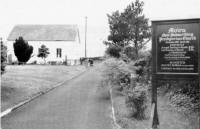 |
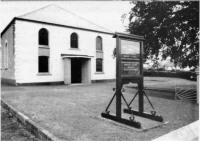 |
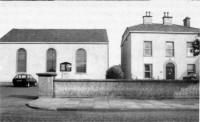 |
|
Non-Subscribing
Presbyterian Church |
Presbyterian Church |
Methodist Church |
�Top
Chapter 6
Nineteenth Century
Records At the end of the
eighteenth century Ireland was plunged in rebellion. The
Northern Presbyterian farmers and the Southern Roman Catholic
Peasantry were on the same side. The counties of Antrim and
Down were very much involved and the principle Ulster battle
was the Battle of Ballynahinch. This was fought on the land of
the Earl of Moira who by this time had moved to Montalto,
Ballynahinch. There followed the Act of Union and the
Nationalism of Daniel O'Connell, the Fenian Movement and the
Catholic Emancipation Movement. The town of Moira, however,
was by all accounts was very little involved, if at all. The
clergyman in charge of Moira from 1818-1821 was Rev. John
Dubourdieu. He was appointed on the death of Rev. John
Bradshaw but was never instituted Rector. In 1821 he became
Rector of Drumgooland (Ballyward). Dr. Dubourdieu was the
author of two books - "A Statistical Survey of Co. Down"
(1802) and a "Statistical Survey of Co. Antrim" (1812). When
John O'Donovan was researching Irish place names for his Irish
Ordinance Survey he encountered Dubourdieu and reported
unflatteringly that he was a "very old, grey-headed peevish
man and a hauty aristocratic self-sufficient little bit of an
Irish Frenchman". There is nothing in his writings or his
relations with his family to indicate that these
characteristics were typical of him. By coincidence, ninety
years after his Incumbency of Moira, the Rector was Rev. Canon
William Hurst whose wife was a grand-daughter of Dr.
Dubourdieu (a Miss Best from Aghalee). In 1847 a terrible
famine took place in Ireland, during which, through death and
emigration, the country lost a great number of people. The
Poor House at Lurgan was full and 70 people died therein one
day. It is surprising that at Moira, only a short distance
away, we find no details of famine distress until the
following year. In 1848 the vestry resolved that "each
person applying for a coffin shall in future furnish a signed
certificate of their religious persuasion and also their
inability to pay for the burial of the deceased, signed by
three persons of good character, being parishioners". That
year Moira parish paid �11.10s ld for coffins. In 1859 the
great Revival began as result of a series of Prayer Meetings
in Kells, Co. Antrim which resulted in a spiritual movement
reverberating around the country in which many churches
literally came alive. Some great preachers made an astonishing
impact with their message. A number of churches were extended
and galleries added in the ensuing years. Although the
gallery in Moira was added around 1871 it is very doubtful
whether it had anything to do with the 1859 Revival. It is
more likely that the large population of household servants in
connection with the various landed gentry and aristocratic
families like the Rawdons, Warings and Berwicks and various
other well-known families was responsible for the erection of
the gallery.
�Top
In 1836 Rev. William Wynne became Rector and remained in Moira
for thirty-seven years until his death in 1873. During his
ministry there were a number of noteworthy curates; Rev.
William Butler Yeats - grandfather of the famous poet of the
same name. He went on to succeed Rev. W m. Wynne as Rector of
Tullylish. Rev. Wynne was married to the daughter of the
Bishop of Dromore, Dr. James Saurin. They had ten children,
two of whom do not seem to have survived infancy. One of his
daughters married one of the curates - Rev. Robert Hannay, who
later became Vicar of Belfast, which included the present St.
Anne's Cathedral Parish. He was the last Vicar of St. Anne's
before it was raised to a Cathedral status with a Dean in
charge. Their son, Rev. John Oliver Hannay, who became Rector
of Ballintoy was the author of many historical novels centred
round the discovery of the Armada ship the Girona which was
discovered off the Antrim coast near Ballintoy around the turn
of the century. He wrote under the pen name George Birmingham
and his books include- The Search Party, Northern Iron and
Spanish Gold, to name but a few. He was also the author of
many theological works. Rev. William Wynne was elevated to
Canon and was later appointed sub-Dean of Dromore Diocese.
Just before his death he was appointed Dean but unfortunately
died before his installation. Another noteable curate was
Rev. James Gaussen who had two curacies in Moira and had
several Chaplancies in Europe, including one at Guernsey,
where there is a lectern Bible dedicated to his memory. Rev.
James Robert Ffolliott, who succeeded Canon Wynne died less
than a year after his appointment and his burial place is
marked by a smaller obelisk in front of the Bateson Memorial.
The next Rector was the Rev. John Knox Barklie who retired
through ill-health in 1898 and went to live in New Zealand at
the home of his son. His successor was Rev. Thomas William
Harpur, whose father Rev. Canon Thomas B. Harpur came to live
at Waringfield House after his retirement as Rector of Ardmore
in 1897. He wrote a book entitled "The Silent Comforter".
Another son as aforementioned was the founder of the Harpur
Memorial Hospital in Menouf Egypt where he had worked as a
missionary doctor. The Rev. Thomas William Harpur served in
two parishes in the South of Ireland after he left Moira.
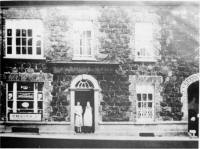 In
the middle of the nineteenth century there seems to have been
a number of complaints about the poor state of Moira Church.
It was considered to be dilapidated. In 1837 the Church was
said to be in "want of repair". There was a disused fireplace
in the vestry and one in the Rawdon pew. The Church was in
need of pointing and plastering. A request was made to the
Commissioner of the ecclesiastics Board for �500, this was
agreed to, but later reduced to �200. In
the middle of the nineteenth century there seems to have been
a number of complaints about the poor state of Moira Church.
It was considered to be dilapidated. In 1837 the Church was
said to be in "want of repair". There was a disused fireplace
in the vestry and one in the Rawdon pew. The Church was in
need of pointing and plastering. A request was made to the
Commissioner of the ecclesiastics Board for �500, this was
agreed to, but later reduced to �200. The spire of the
Church blew down in a freak gale in 1884. A new copper spire
was erected at a cost of �370. It is one of the landmarks of
the countryside. The Church in this century has seen many
changes. The oil lighting system had been installed and was in
use until the year 1933 when it was replaced by electricity
both in the Church and Rectory at a cost of �30. In the year
1933 oil fired heating replaced the stove in the middle of the
Church. To mark the 250th Anniversary of the Church the
present lighting was installed and is very much in keeping
with the Georgian architecture of the Church. The
floodlighting system was offered by Mrs. H. Jordan in memory
of her husband Hercules Jordan. At the beginning of the
century the organ was installed by Mr. J.L. Douie in memory of
his wife Mary Lothian Douie. At this time the choir seating
was rearranged and the pulpit moved back and lowered one foot.
A brass lectern was also presented by the Douie family in
memory of the Rev. James Douie. The organ was re-built in 1978
at a cost of �8,000.
�Top
Chapter 7
The
Present Day The letter H appears quite often
in the list of Rectors. The first clergyman had been the Rev.
Hugh Hill, one of his successors was Rev. George Howse. At the
turn of the century the Rev. Thomas Harpur was Rector. He was
succeeded by the Rev. William Hurst. During the 2nd World War,
the Rector was the Rev. Henry Hughes, later of Dean of
Dromore. Two of these clerics were in Moira over thirty years.
Before the Church had been built, the parishioners had
worshipped in the local Charity School. The Earl of Moira
re-built the school (probably on the same site). At the
beginning of this century, the land steward of the Deramore
Estate, Mr. J.L. Douie, built a new school, replacing the one
built by the Earl of Moira. In recent years the present
primary school was built. Approximately eighteen years ago the
old school was transferred into the hands of the Church and is
now used as an extra Church building. Rev. William Hurst was
Rector of the Parish during the years of the first World War.
Ireland again was plunged into rebellion. The great rising of
1916 broke out and in 1921 after the War there was another
rising. Partition followed, and the country was divided. The
Northern Six Counties remained with Great Britain and the
remaining twenty-six counties became the Irish Free State. It
was declared a Republic twenty-five years later. The Church
in this century has seen many changes. The oil lighting system
had been installed and was in use until the year 1933 when it
was replaced by electricity both in the Church and Rectory at
a cost of �30. To mark the two hundred and fifty anniversary
of the Church the present lighting was installed and is very
much in keeping with the Georgian architecture. The flood
lighting was presented by Mrs. Hercules Jordan in memory of
her husband. The Communion Table was also presented by the
Jordan family around the same time. At the beginning of the
century the organ was installed by Mr. J.L. Douie in memory of
his wife Mary Lothian Douie. At this time the choir seating
was arranged and the pulpit moved back to it's present
position and lowered by one foot. A brass lectern was also
presented by the Douie family in memory of the Rev. James
Douie. The organ was re-built in 1978 at a cost of
approximately �8,000. After the First World War, the town
War Memorial was erected in front of the Church at a cost of
�215 and was unveiled by Mrs. Waring of Waringstown in 1921.
Wreaths are laid every year on Remembrance Sunday to
commemorate those who fought and died for their Country. After
the Second World War the names of those who gave their lives
were added to this Memorial. A Roll of Honour to those who
served and fought in the two World Wars is found in the porch
of the Church. This was presented by Mr. Robert Logan of
Bangor.
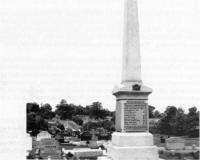 |
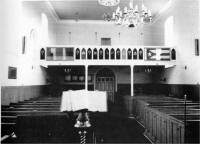 |
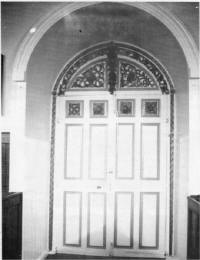 |
| War
Memorial |
Moira
Church
|
| |
|
Inner
Door to Porch |
Following a ministry of thirty-two years Canon Hurst
retired from the Parish as a result of ill health. Throughout
his period in Moira he had farmed extensively. He and his wife
went to live in Newcastle. His elder son Walter entered the
ministry and spent most of his ordained life in New Zealand.
He was first Dean of Dunedin and at the time of his death a
few years ago was Dean of Wellington. The younger son, Noel,
was a successful farmer and market gardener in New Zealand and
now enjoys retirement. Their daughter Elma is married to a
well known solicitor in Downpatrick.
The new Rector was the Rev. Henry Hughes who had been a
Deputation Secretary for the Church of Ireland Jews Society
and also Rector of a Parish in Co. Wicklow. He was Rector of
Moira for thirty-one years and ministered throughout the
period of the Second World War. He was a man of great
scholarship and learning. His wife, formerly Dr. Mary Dobson
from Waringstown_ assisted many local doctors during her stay
in Moira. Rev. Hughes, who later became a Canon of Dromore
Diocese and ended his ministry as Dean of Dromore was also a
Scout Commissioner and Mrs. Hughes was a Girl Guide
Commissioner. In 1947 the Women's Guild was founded.
�Top
Around the same period the pew at the back of the Church was
converted into baptistry. Three years later the East window
was presented by Mrs. Logan of Trummery in memory of her
husband, depicting St. John. On one occasion when the Church
was being redecorated it was discovered there just to be a
Coat of Arms painted on the pulpit. It had become completely
indecipherable. The parish was given permission to replace it
with the Diocesan Crests. During the last War the Ulster
Military Hospital was at Waringfield in Moira. The buildings
consisted of nissen huts in the grounds of the large mansion.
Many wounded soldiers from all parts of the world were treated
at this hospital. Regularly soldiers who were encamped in the
Castle Demesne. When the Ulster Military Hospital was
transferred to Musgrave Park Hospital about thirty years ago
the Royal Army Medical Corps presented their flag to Moira
Parish. It is now displayed on the front of the gallery beside
the insignia of the Queens Forces. The flag on the other side
of the gallery is that of Cuba, before Fidel Castro's
revolution. It was presented to Dean Hughes at a Scout
Jamboree. This flag is probably unique to any other Church in
the world.
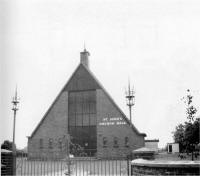 |
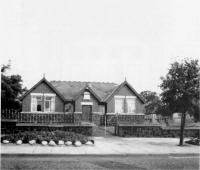 |
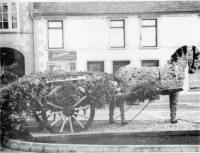 |
| Parochial
Hall |
Old
School |
Floral
Horse |
In 1960 the Parochial Hall began to be built. As early as
1953, in order to meet the needs of the various parochial
organisations it was felt a Parochial Hall was a necessity. At
this stage the organisations were housed in the Town Hall and
the Orange Hall and also in the Rectory cellars. It was
considered the Town Hall be bought as a Parochial Hall, but it
was soon discovered that too many structural alterations would
have to be made and it would have been too costly. In 1954 a
local builder, William Martin, presented to the Parish a piece
of ground in the Main Street for the building of this Hall. In
1960 the foundation stones were laid and by the following year
the Parochial Hall was opened. The Architect was Mr. Denis O'
D Hanna. The cost was �8,000 and was raised by parisoners in a
comparatively short space of time. At this stage also the
Church and Rectory were renovated. The present Primary
School was built in the early 1970's and in 1975 the Old
School was handed back to the Church as an auxiliary hall. The
Charter had indicated that when it ceased to be in use as a
school it was to become the property of the Church. It was
opened as a Youth Hall in 1975. In 1960 the M1 Motorway was
constructed and by the year 1966 a roundabout junction at
Moira on the M1 facilitated commuting to Lisburn and Belfast.
It is due to the building of this motorway and the subsequent
movement from towns like Lisburn that the present town has
developed. Moira is now achieving the reputation of being
fastest growing small town in the Province. In recent years
Lisburn Borough Council has taken great pride in providing
flower beds and hanging baskets. Their efforts have not been
in vain as Moira has won many competitions i.e. Ulster in
Bloom; Best kept small Town in the Province. It has featured
in Britain in Bloom and even reached the European finals of
the Entente Florale. In the past fifteen years many new
housing developments have grown up in new estates. The town
has developed both numerically and commercially. Many
successful businesses have arrived in the area and have
brought much prosperity. Great improvements have taken place
in the appearance of the town. Most of the stone buildings
have been repointed and the beauty of the Georgian buildings
have been enhanced. When the Church was redecorated in 1991
many improvements were made to the interior of the Church -
the electrical lighting was augmented and much of the woodwork
was brought back to it's original colour. The Church was
completely re-roofed with particular care being taken to
ensure that the replacement slates were in keeping with the
age of the building. It was at least over one hundred years
since previous extensive repairs were carried out. Most of the
timbers were found to be absolutely sound. Together with
Government grants and the sacrificial giving of parishioners
much of the expense has been cleared. Various gifts were
donated to the Church at the Re-dedication service - Baptismal
font; Middle Aisle and Chancel Carpet; West Entrance Door;
Music Bookcase and Music Shelf; Gallery Pew; Electric Light
Chandeliers and silver collection plates. The Church is now in
extremely good condition and has a commanding appearance and
is a landmark for many miles. The Select Vestry are to
commended for all the marvellous work they have done with
particular mention to those who supervised the repairs and
directed the work.
Repairs and re-decorations were also carried out to the
Parochial Hall to meet Fire Authority Regulations. New stage
and window curtains were also purchased together with
regulation fire doors.
Rectors
and Clergy-in-Charge
| 1722 - Hugh Hill |
| 1729 - John Gifford (Buried in Moira) |
| 1736 - George Howse |
| 1743 - Thomas Waring (Buried in Moira) |
| 1776 - St. John Blacker |
| 1783 - Andrew Greenfield (Buried in Moira) |
| 1788 - Verney Lovett (Later Chaplain to
H.R.H. Prince of Wales) |
| 1789 - Charles William Moore |
| 1808 - John Bradshaw |
| 1818 - John Dubourdieu |
| 1821 - Lewis Saurin |
| 1829 - Thomas Beatty |
| 1836 - William Henry Wynne
(Buried in Moira) |
| 1873 - James Robert
Ffolliott (Buried in Moira) |
| 1874 - John Knox Barklie |
| 1898 - Thomas William
Harpur |
| 1907 - William E.
Hurst (Buried in Moira) |
| 1939 - Henry
Hughes (Buried in
Moira) |
| 1971 - John
McCarthy |
| 1975 - Charles
Robert Jordeson
Rudd |
* Clergy-in-Charge
�Top |